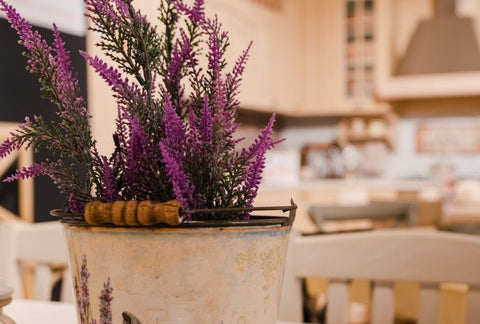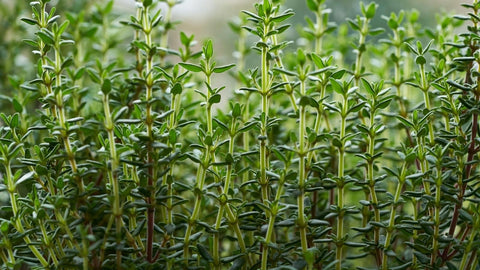Rosemary is native to the Mediterranean coast – where it would use its needle-like leaves to collect moisture out of the sea-sprayed air. Its name comes from Latin ros-marinus, which translates to “dew of the sea”.

Timing
Sprouts in 2-3 weeks. Harvest from Month 4+ on.

Part sun
Equivalent of 5+ hours of direct sun [DLI of 15+ mol/m²/day].

Care
A bit tricky to water correctly, but otherwise low-maintenance.
Can You Grow Rosemary Indoors?: Best Rosemary Varieties to Grow Inside
The most important question is – can you grow rosemary indoors? Yes, you can! Most Rosemary at garden centers are sold as ornamental plants – and have been selected for looks – not flavor. While many can be used for cooking, the best varieties have soft leaves with concentrated essential oils. The other factor to consider is the plant shape; they can either be upright shrubs, topiaries, or creeping vines that drape over your container.
Our favorite types are:
Mrs. Howards
Creeping
The creeping varieties tend to be less aromatic – but this is an exception.
Garden DirectCommon Rosemary – Primed Seed
Upright
If starting from seed – primed is necessary for rosemary.
AmazonHow to Grow Your Rosemary in the House: Starting Your Rosemary Plants
To start growing rosemary indoors from seed, you’ll need:
Planter:
Ceramic Self Watering Planter (preferred) or pot that is at least 8″ / 1 gal.
Best Soil for Rosemary:
Free-Draining Mix is one of the best soil mixes for rosemary, if not the best.
Plant Food:
At the start: Balanced Blend. This should be equal parts nitrogen, phosphorus, and potassium (with NPK numbers like 10-10-10).
Ongoing: Herb Blend. This should be high in nitrogen (with NPK numbers like 10-5-5)
Rosemary Grow Light:
A strong rosemary grow light that can give the equivalent of 5+ hours of direct sun [DLI of 15+ mol/m²/day].
Jump to: Our product recommendations
Preparing your Planter & Watering Schedule for Rosemary Indoor Growing
Rosemary indoor growing is not that easy, especially in moist soil conditions. The roots are not accustomed to being too wet and will rot in boggy conditions. On the other hand, if the soil dries out completely the roots will die back and the plant won’t recover. This can catch you off guard because the plant’s not very expressive (its leaves don’t wilt) so it will look fine right up until it dies.
A Ceramic Self Watering Planter filled with a free-draining potting mix self-regulates to keep the soil on the drier side, but with a little consistent moisture (and means no watering guesswork for you). Careful of wick-based self-watering planters with Rosemary – as they tend to be too wet.
To set one up:

- Fill up the planter with dry soil from the bag, gently tamping down the top.
- Dump the soil into a large mixing bowl and add water until the soil is moist, but not sopping wet (about ½ Cup)
- Mix in 1 tablespoon of the Balanced Blend Plant Food.
If you are using a regular pot instead, it should be a little bit bigger (at least 8″ / 1 gal) and will need drainage holes to prevent it from being overwatered. Let the top of the soil dry out between watering.
Starting your Rosemary: Seed vs Propagate vs Nursery Plant
Rosemary is usually started with a live plant or cutting. It’s possible to grow it from seed, but it takes a long time and many of the best varieties can only be grown from cuttings.
How to Plant Rosemary seeds

Rosemary is a bit slow to start from seed – but is totally doable. Plant 1 site in an 8″ / 1 gal container. In larger containers, space sites 8″ apart. For each site plant press 10 seeds into the surface. Keep the soil warm (70-80°F), ideally 75°F. Sprouts typically appear in 20 days but can be as quick as 14 days or as long as 25 days depending on your conditions. Don’t cover the seeds as light helps them sprout.
Propagating Rosemary: How to Clone from a Stem Cutting

If you’ve already got a Rosemary plant you love (or a friend does!) you can easily “clone” it with just sharp scissors and a clean glass of water. First, cut a couple 6” shoots of new growth (avoid anything woody). Next, remove the lower leaves, so the bottom half is just stem. Place in a glass of 3” of water, making sure the cut leaf spots are underwater. Place the glass on a bright windowsill and change the water every few days. In a couple of weeks, roots should emerge and you can transplant them into your container. While using additional rooting hormones won’t hurt, it’s not necessary with Rosemary plants.
- Cut 6” section of new growth
- Remove leaves halfway and place them in the water on a sunny windowsill
- Wait 14-28 days for a few ½ inch roots to form and carefully transplant into its final container
How to Transplant Rosemary
Live starter plants give you a big jump start on your first harvest. When you’re in a garden center – pick the bushiest plant available (tall and lanky ones will be weak growers) and give it a good inspection for pests. Leaves should be dark green without holes, spots, or curled edges. A best practice is to actually “quarantine” your plant for about a week after bringing it home to make sure it’s free and clear of ride-on pests.

Ensuring it’s pest and disease-free, it’s time to transplant your seedling into its final home.
- Remove some soil from its final planter – leaving enough space for the bottom of the seedling to be just higher than the soil surface.
- Hold on to the base of the stem with one hand, and turn the pot over while gently pulling the seedling. Giving the pot a few squeezes can help dislodge it.
- Place in its final container and fill around it with soil so that it’s tight, but not compacted.
Where to grow your Rosemary plants
Like all edible plants, Rosemary plants need lots of light to grow and develop good flavor. Sunlight is excellent for plant growth (and free!) and you might be lucky enough to have a spot that’s got the 5+ hours of direct sun they need. Even with a bright window, it’s unlikely that you’ll have enough natural light in the winter so we recommend a grow light for anyone who wants a constant supply of flavorful produce. For an introduction to grow lights, head over to our post on grow lights for indoor gardeners. We’ve also got a buying guide for screw in types, but to keep things simple in this guide, we’ll just provide directions for the 24W Screw in Bulb by Sansi, which we think is a good middle-of-the-road option.

How bright should your rosemary light be?
Rosemary plants need the equivalent of 5+ hours of direct sunlight [DLI of 15+ mol/m²/day] to grow their best. In order to provide an equivalent amount with your rosemary light, it needs to be pretty bright! The 24W Sansi bulb should be placed 6 inches away from the top of the plant. This will give your PPFD (the standard measure of brightness) of 500 μmol/m²/s.
How many hours per day do your Rosemary plants need under a grow light?
Rosemary plants are what’s known as “day-neutral” so can grow under a range of daylight lengths. In order for them to get enough light, we recommend setting up a timer to leave it on for 10+ hours per day.
Rosemary Plants Grow Faster in Warmer Temps
Rosemary plants are called “warm-weather crops” and will speed up their metabolism when temperatures are warmer. On the other hand, if things get too hot they’ll wilt and become prone to disease. Ideal temperatures are around 70°F but anything between 55 and 80°F grows well.
Week 2-3: Check for Sprouts
You could see seedlings in as little as 14 days (though 20 days is more typical). If it’s been 25 days and you still don’t have any sprouts, it’s likely that your setup is too cold.
How to Take Care of Rosemary Indoors: Week 4 – Thin Your Seedlings

To take care of rosemary indoors, thin your planter to only have 1 seedling per site – leaving the largest plant. If you are using the recommended planter (at least 8″ / 1 gal) this will mean you’ve got 1 plant after thinning. By getting rid of the smaller seedlings, you’re allowing the biggest and strongest one to flourish by reducing its competition for water, food, and space. If your seedlings are under 1 inch, stretching out, or folding over, it’s likely that they don’t have quite enough light.
How to Care for Rosemary Indoors: Month 3 – How to Prune Rosemary Plants

Caring for rosemary indoors includes pruning it on month 3 from the time that you planted it. Once your Rosemary plant has 3 sets of mature leaves you’re ready for your prune. Cut off the top set of mature leaves, leaving the bottom two (it’s best to cut right above the pair of leaves you’re keeping on the plant). Once these branches grow out (and each has a few sets of their own leaves) you can cut the tip – just as you did with the main stem. At this point your plant will be fairly well-shaped, so hone your inner Bonzi master and use your thinning and heading cuts to harvest and shape your herbs as you go.
Month 4+: How to Harvest Rosemary
After 4 months you can make a small harvest of stem tips. After 6 months you should be able to harvest bunches. Let the soil dry out between watering.
Year 10+: End of Life
Rosemary can live for a very very long time if the conditions are right. If you live somewhere with colder winters, be sure to bring your rosemary in before the temperatures drop.
Shop This Blog
The right supplies can take the guesswork out of caring for your plants – and turn care from a daily to weekly routine. Through our grow tests, we’ve found these products to produce the best indoor Rosemary (and also have simple maintenance). Plants are adaptable and can grow in many different conditions, so they are by no means necessary if you already have other supplies.
Best Containers for Rosemary: Ceramic Self Watering Planters
Plants thrive on consistent moisture but can suffer if they’re waterlogged. A semi-porous ceramic self regulates ideal conditions. Our favorite is the COSWIP planter. Runner up is XS Self Watering Planter by Wet Pot.
Best Soil for Rosemary: Free Draining Mix
Rosemary needs a drier environment – so you are better off using a free-draining cactus potting mix – we like this Organic Mix by Espoma.
Best Nutrients for Rosemary: Balanced Blend followed by Herb & Lettuce Blend
Rosemary likes to start with nutrients that are equal parts nitrogen, phosphorus, and potassium (with NPK numbers like 10-10-10). For this Balanced Blend we recommend: Dr Earth All Purpose.
Once they are growing, it’s better to use plant food that is high in nitrogen (with NPK numbers like 10-5-5). For this Herb Blend, we recommend: Joyful Dirt All Purpose.
Best Light for Rosemary: DIY or Soltech
There is a very small chance that you have the bright windows needed to grow these without a grow light. If you are looking for a higher-end option – we love the Aspect Light by Soltech. For a more affordable option, a DIY setup using a 24W Screw-in Bulb by Sansi with a Clamp Light and Mechanical Timer works well too. Check out our complete guide on a DIY setup for less than $40 or our buying guide for screw-in bulbs.









There are no comments for this article. Be the first one to leave a message!